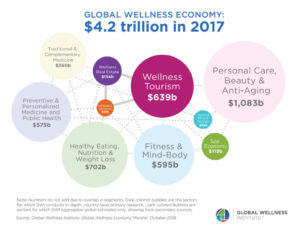Good Health is Good Business: Wellness Industry Approaches $4.2 Trillion
It’s no secret the healthcare industry is in shambles, with the U.S. at the head of the frustration parade. The newest insights from the Deloitte 2019 Global health care outlook are shocking.
Per-person health care spending in the U.S. is expected to reach $11,674 by 2022 (compared to just $54 in Pakistan). But the higher per-person spending doesn’t necessarily equate to higher-quality health care. When compared to 10 developed countries, the U.S. ranks last in overall health care performance. To sum it up, our per capita spending is 50% greater than the next country. But the U.S. is in last place for efficiency, equity, and healthy lives.
Insurance costs are skyrocketing, yet hospitals and healthcare facilities are struggling for life and many primary care physicians are closing their doors. So where are all of these expenditures going? Most of the profit in the current system, according to reports, is going to big pharma. U.S. prescription drug spending per person has ballooned from $90 in 1960 to $1,025 in 2017. Not surprisingly, more than 25 percent of adults who take prescription medication say they have a “somewhat” or “very” difficult time affording their treatment, according to a Kaiser Family Foundation poll.
These statistics speak to a paradigm that is very close to my heart. Imagine the increase to productivity, well-being and happiness of our lives if we could move from a paradigm of treating sickness to protecting our wellness?
Not only would we be running more productive businesses and leading happier lives, we’d be more profitable, too. For entrepreneurs, the news is even better when you consider the wellness industry itself.
As an industry sector, wellness has grown by 6.4 percent annually from 2015–2017, according to the Global Wellness Institute. Wellness is now a $4.2 trillion market that is growing nearly twice as fast as the global economy (3.6 percent annually, based on IMF data). In all, the wellness industry represents 5.3 percent of global economic output.
Consider the many possibilities for productive and profitable business in this. Education businesses can teach consumers the full advantages of better nutrition and can take the training further by helping consumers adapt. Cookbooks and nutritional classes for prevention and management of diabetes, for example, can help to change people’s future. Healthier restaurants and food products. A return to locally grown and natural foods. Exercise and wellness programs. New modalities of exercise and supplementation.
This week an emerging voice in the IoT aspects of preventative health care announced a technology company called Medic.life has been working since 1999 on the development of an AI toilet that monitors key health and wellness indicators during every bathroom stop. The product is currently in late beta, but within 2-3 years should be available for healthcare and acute treatment facilities. Utlimately, the company hopes to make the technology available for homes and consumers as well. David Hall, the company’s founder, is passionate about advancing the ability to identify trends that can strengthen wellness, which can help us, as a culture, to do a better job of protecting ourselves against disease in advance. (He’s the same David Hall at the helm of the Hall Labs Innovation Center that houses some 19 portfolio companies and has been named one of the nation’s top three Opportunity Zones for economic development and tax-advantaged investing that I mentioned in one of my prior columns in March.)
In Medic’s recent news, Hall noted the following:
- One in five U.S. adults have high blood pressure and are unaware of it, according to the CDC.
- 60 percent have one or more chronic conditions that are mostly preventable, according to Rand.
- 90 percent are not aware they are prediabetic.
- Likewise, the National Kidney Foundation reports that 90 percent don’t know they’re in the early stages of kidney disease.
Imagine the opportunities for this company, which has amassed more than 60 patents and patent applications related to improving health monitoring and disease preventability care.
Oversight is paramount in the burgeoning sector, as the opportunity has led to a plethora of questionable treatments and cures. But if we handle this sector with responsibility it may deliver as much or more opportunity than any other sector to create businesses that can change our outlook, advance our economy, and improve the quality and vitality of millions of lives. I look forward to reporting and helping to advance many such technologies in the seasons to come.
Photo Credits: Mental Health Association and Global Wellness Institute

